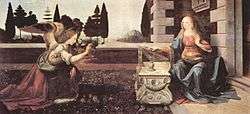Lady Day

In the western liturgical year, Lady Day is the traditional name in some English speaking countries of the Feast of the Annunciation (25 March), known in the 1549 Prayer Book of Edward VI and the 1662 Book of Common Prayer as "The Annunciation of the (Blessed) Virgin Mary" but more accurately (as currently in the 1997 Calendar of the Church of England) termed "The Annunciation of our Lord to the Blessed Virgin Mary". It is the first of the four traditional English quarter days. The "Lady" is the Virgin Mary. The term derives from Middle English, when some nouns lost their genitive inflections. "Lady" would later gain an -s genitive ending, and therefore the name means "Lady's day".
Non-religious significance
In England, Lady Day was New Year's Day between 1155 and 1752, when 1 January was declared to be the official start of the year.[1] A vestige of this remains in the United Kingdom's tax year, which starts on 6 April, i.e., Lady Day adjusted for the lost days of the calendar change. Until this change Lady Day had been used as the start of the legal year. This should be distinguished from the liturgical and historical year. It appears that in England and Wales, from at least the late 14th century, New Year's Day was celebrated on 1 January as part of Yule.[2] Before 1751 the year began in March.
As a year-end and quarter day that conveniently did not fall within or between the seasons for ploughing and harvesting, Lady Day was a traditional day on which year-long contracts between landowners and tenant farmers would begin and end in England and nearby lands (although there were regional variations). Farmers' time of "entry" into new farms and onto new fields was often this day.[3][4] As a result, farming families who were changing farms would travel from the old farm to the new one on Lady Day. After the calendar change, "Old Lady Day" (5 April), the former date of the Annunciation, largely assumed this role. The date is significant in some of the works of Thomas Hardy, such as Tess of the d'Urbervilles and Far from the Madding Crowd.
The logic of using Lady Day as the start of the year is that it roughly coincides with Equinox (when the length of day and night is equal); many ancient cultures still use this time as the start of the new year, for example, the Iranian new year and the original Hebrew new year. In some traditions it also reckons years AD from the moment of the Annunciation, which is considered to take place at the moment of the conception of Jesus at the Annunciation rather than at the moment of his birth at Christmas.
In Ireland, however, Lady's Day means 15 August, the Feast of the Assumption of Mary, and is a day when fairs are celebrated in many country towns.
See also
References
- ↑ Catholic Encyclopedia, General Chronology (Beginning of the Year).
- ↑ See Sir Gawain and the Green Knight Fytte Three
- ↑ Adams, Leonard P. "Agricultural Depression and Farm Relief in England, 1813–1852" Reviewed in Journal of the Royal Statistical Society, 95(4):735–737 (1932)
- ↑ "The Tenant League v. Common Sense" Irish Quarterly Review 1(1):25–45 (March, 1851)